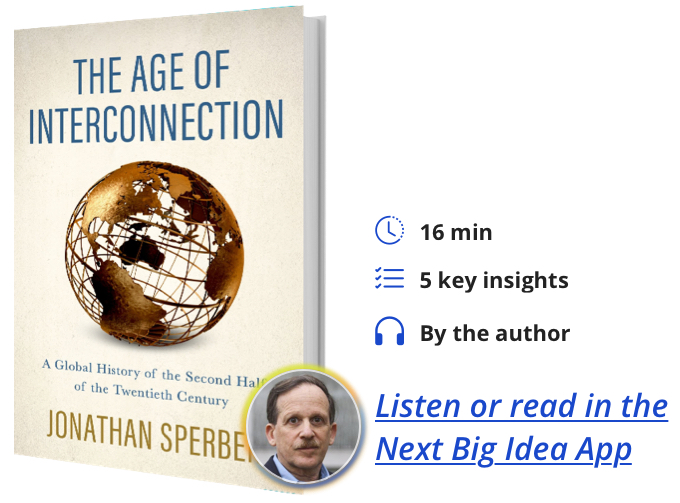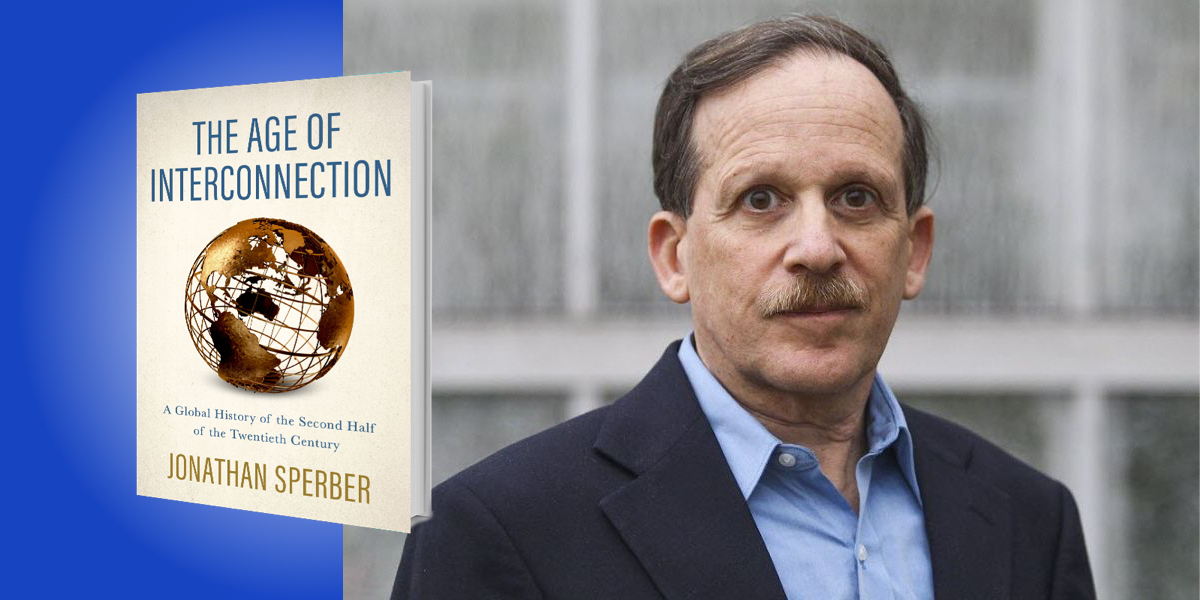Jonathan Sperber is the Curators’ Distinguished Professor of History Emeritus at the University of Missouri. One of his previous books, Karl Marx: A Nineteenth Century Life, was a finalist for the 2014 Pulitzer Prize in biography.
Below, Jonathan shares 5 key insights from his new book, The Age of Interconnection: A Global History of the Second Half of the Twentieth Century. Listen to the audio version—read by Jonathan himself—in the Next Big Idea App.

1. Illuminating the present.
The second half of the twentieth century, or the years between V-J Day in 1945 and 9/11 in 2001, contained remarkable and spectacular developments—humans walking on the moon, the constant threat of a thermonuclear war that would destroy all life on earth, the elimination of diseases such as smallpox that had been a millennia-long scourge on humanity, and the end to the largest colonial empires in human history, to name just a few. Maybe the impact of those events is a little too strong, and the past too recent, because many historians’ accounts amount to a reiteration of old newspaper headlines, talking about one crisis after another, or gee-whiz descriptions of scientific and technological marvels. The main themes (usually historians’ strong points) are missing.
Pundits rush in with a variety of slogans to characterize the era, including “globalization,” “the world is flat,” or the “singularity.” This approach lacks historical context, flattens the past, and fails to make distinctions between the past and the present.
The point of The Age of Interconnection is to analyze the recent past and look at the structures and developments that shaped headlines. This way of proceeding has the two great virtues of historical analysis that illuminate the present: tracing how the past differs from the present, and how the present developed out of the past.
2. The inconsistent rise of global interconnectedness.
One main theme of the second half of the twentieth century is global interconnections: the increasing extent to which individuals, ideas, cultural practices, goods, and capital crossed boundaries of sovereign states, continents, and oceans, creating globally encompassing systems. A world not just of connection but of interconnection.
“Common developments across the globe could play out very differently in countries with different political systems, social structures, or states of economic development.”
In contrast to naive ideas about “globalization,” creating an interconnected world was not continuous or consistent. Common developments across the globe could play out very differently in countries with different political systems, social structures, or states of economic development—something that became apparent during the COVID pandemic, but which had many precursors. Global interconnections in some areas could lead to their rejection in others. The enormous increases in world-wide trade, financial transactions, and cross-border investments have not resulted in cosmopolitan attitudes, but in xenophobic nationalism and intolerant forms of religion.
3. The impact of the age of total war.
The second main theme is the impact of the age of total war, the years 1914–1945, on the second half of the twentieth century. Major features of international relations during that time, such as the Cold War, were directly shaped by the course and outcome of the Second World War. While the impact of the age of total war was greatest in the decades immediately after 1945, it could extend until the end of the century. The fall of the Berlin Wall, the end of the communist Eastern Bloc, and the unification of the two German states in 1989-90 marked the end of the Cold War, but they were also the final, legal end of the Second World War.
The impact of the age of total war was extraordinarily widespread. Central elements of post-1945 technology—jet aircraft, rockets, nuclear power and nuclear weapons, antibiotics, television, solid-state circuits—were products of the age of total war. Another impact of the age of total war is in the division of the second half of the twentieth century into specific periods: a postwar era, from 1945 to the early 1960s, when social, economic, political, demographic, and diplomatic structures largely derived from the era of total war; an age of upheaval, in the 1960s and 1970s, when those structures were destroyed; and the final two decades of the century, the “Late Millennium Era,” as I call the years 1980 – 2001, when the contours of the contemporary world came into existence.
4. Humans’ changing relationship with the environment.
The combination of growing global interconnection and the heritage of the age of total war altered human interaction with the environment. The postwar era saw the fastest rates of economic and population growth worldwide of any time in human history, before or since. Long-standing practices for dealing with the pollution from expanding industrial and agricultural production reached their physical limits. The environmental impacts of older sources of pollution (coal smoke or leaded gasoline) as well as newer ones (including DDT or radioactive fallout) were increasingly apparent.
Attempts to deal with this developed gradually, getting a large charge from the cultural and political changes of the 1960s. Most thinking about human impact on the biosphere in this period followed along the lines set out by Thomas Malthus and his predictions of population invariably outstripping food supply. Widespread apprehension of imminent mass starvation was characteristic of environmental concerns in the 1950s and 1960s.
“Long-standing practices for dealing with the pollution from expanding industrial and agricultural production reached their physical limits.”
The predicted famines never came in spite of the rapid pace of population increase that resulted from the “Green Revolution,” the spread of the agricultural technology of hybridizing grains around the world. Norman Borlaug, the Iowa biologist who was central to that effort, is the most important person you haven’t heard of in the second half of the twentieth century.
In the 1970s, the number of national environmental agencies or government ministries around the world increased from about 20 to some 180 a decade later. The first oil price shock of 1973 and the gasoline shortages stemming from it seemed to underscore the argument; a crucial resource was already running out. In the end, the oil price shocks, while a distinct turning point for the global economy, were not a signal of a declining supply of natural resources. While there was modest progress in environmental remediation, including the end of leaded gasoline, improved water purity, and declines in atmospheric sulfur dioxide and nitrogen oxides, environmental degradation in the communist countries of the Eastern Bloc continued and played a distinct role in communism’s end in eastern Europe from 1989 to 1991.
In the late millennium era, new environmental issues appeared, particularly those connected with greenhouse gases and the use of chemicals that destroyed the ozone layer. These issues were different from previous forms of human impact on the environment: not immediately perceptible, as was smog in the air, or filthy streams; emissions’ impact was globalized, crossing borders, rather than concentrated where they originated. They were also relatively recent. Large-scale production of chemicals harming the ozone layer only began in the 1960s; and in 1960 carbon dioxide concentrations in the atmosphere were just 5 percent above pre-industrial levels.
Coming to broader public attention, these two new forms of human impact had very different resolution. The Montreal Accord of 1987 began the global elimination of chemicals harmful to the ozone layer. Successfully implemented and repeatedly reinforced, with more chemicals added to the banned list, and more countries joining the prohibitions, the result has been the ozone layer’s gradual recuperation. The 1997 Kyoto Protocol, designed to limit greenhouse gas emissions, has been a complete failure; CO2 emissions and global temperatures have risen rapidly and substantially since then.
5. Moments of utopian aspiration.
Our last point concerns the three great, worldwide waves of utopian aspirations. The Second World War was the greatest war in human history, with the most loss of life, massive political and socioeconomic upheaval, and the use of unprecedented weaponry. These were apocalyptic circumstances, and the war ended on a wave of apocalyptic expectations: fears of a nuclear war; hopes of a new, just, and emancipatory world. These hopes were found among adherents of resistance to Nazi occupation, who connected liberation from Nazi rule with social and political revolution; among anti-imperialists in Africa and Asia, who saw liberation from colonial rule as leading to a better stage in human history and, almost everywhere, in the great hopes for global governance to preserve peace and expand human rights, embodied in the newly formed United Nations. The postwar era saw the apocalypse denied: postwar Europe brought not utopias but consumer societies or bureaucratic Stalinist domination; newly independent countries liberated from imperialist rule were not paragons of virtue; the UN was hamstrung by the Cold War and by refusal of the powers to give up any sovereign authority.
“But in the end, the utopian aspirations faltered, defeated by government repression, nationalist hostilities, political co-optation and the end of postwar prosperity.”
A second wave of utopian aspirations was associated with the mass movements of the 1960s. Often seen as embodied in affluent young people in the world’s wealthy countries, these mass movements were actually world-wide: not just Berkeley, Paris, West Berlin, or New York, but also Prague, Warsaw, Mexico City, Montevideo, Dakar, Shanghai, and Dhaka. And not only educated and affluent young people, but impoverished members of racial minorities and older, salaried employees, blue-collar workers, and peasants. Unlike the post-1945 utopian aspirations emerging from total war and socioeconomic crisis, these mass movements came out of decades of prosperity and economic growth; demands for greater participation in universities, industrial enterprises, or government were characteristic and presupposed a continuation of postwar prosperity. But in the end, the utopian aspirations faltered, defeated by government repression, nationalist hostilities, political co-optation and the end of postwar prosperity. The 1970s and 1980s movements in favor of women’s rights, environmental protection, and human rights emerged from this matrix of 1960s utopian aspirations.
The third wave of utopian aspirations was connected to the mass movements of 1989 in opposition to communist rule in Eurasia. The end of communism became increasingly understood as legitimating its Cold War rival, capitalism, in its particularly militant 1980s form, as it had developed from the extreme libertarian ideas of University of Chicago economist Milton Friedman and practiced by the right-wing governments of Ronald Reagan and Margaret Thatcher. The post-Cold War future would unleash markets worldwide, through privatization and deregulation. The United States would create and dominate, as U.S. President George H.W. Bush said, “a new world order.” Unlike the left-wing utopian aspirations of 1945 and 1968, post-1989 utopias were conservative, promoted by pundits, think-tankers, bankers, and economists. Privatization and deregulation brought not prosperity to post-communist eastern Europe but social chaos, organized criminality, and economic decline. Unleashed global financial markets produced financial crises in Mexico, East Asia, and Russia between 1994 and 1998, and then across the world in 2008. Opposition to a U.S. hegemony ensuring a world of deregulated markets increased, first among Islamists, and then among authoritarian nationalists, who rejected a U.S.-led multilateral order. Like the two previous waves of utopian aspirations, this one proved to be, well, utopian.
To listen to the audio version read by author Jonathan Sperber, download the Next Big Idea App today:































